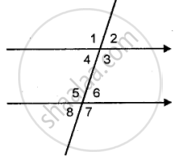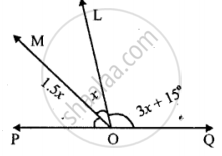Advertisements
Advertisements
प्रश्न
If ∠1 = 120°, find the measures of : ∠2, ∠3, ∠4, ∠5, ∠6, ∠7 and ∠8. Give reasons.

उत्तर
l || m and p is their transversal and ∠1 = 120°
∠1 + ∠2 = 180° (Straight line angle)
∴ 120° + ∠2 = 180°
⇒ ∠2 = 180° - 120° = 60°
∴ ∠2 = 60°
But ∠1 = ∠3 (Vertically opposite angles)
∴ ∠3 = ∠1 = 120°
Similarly ∠4 = ∠2 (Vertically opposite angles)
∴ ∠4 = 60°
∠5 = ∠1 (Corresponding angles)
∴ ∠5 = 120°
Similarly ∠6 = ∠2 (Corresponding angles)
∴ ∠6 = 60°
∠7 = ∠5 (Vertically opposite angles)
∴ ∠7 = 120°
and ∠8 = ∠6 (Vertically opposite angles)
∴ ∠8 = 60°
Hence ∠2 = 60°, ∠3 = 120°, ∠4 = 60°,∠5 = 120°, ∠6 = 60°, ∠7 = 120° and ∠8 = 60°.
APPEARS IN
संबंधित प्रश्न
The adjoining figure shows two straight lines AB and CD intersecting at point P. If ∠BPC = 4x – 5° and ∠APD = 3x + 15°; find:

(i) the value of x.
(ii) ∠APD
(iii) ∠BPD
(iv) ∠BPC
Construct the 45° angle, using ruler and a pair of compass only.
Construct the 30° angle, using ruler and a pair of compass only.
Draw a line segment PQ = 8cm. Construct the perpendicular bisector of the line segment PQ. Let the perpendicular bisector drawn meet PQ at point R. Measure the lengths of PR and QR. Is PR = QR?
Draw a line segment OA = 5 cm. Use set-square to construct angle AOB = 60°, such that OB = 3 cm. Join A and B; then measure the length of AB.
Draw a line segment OP = 8cm. Use set-square to construct ∠POQ = 90°; such that OQ = 6 cm. Join P and Q; then measure the length of PQ.
Draw ∠ABC = 120°. Bisect the angle using ruler and compasses. Measure each angle so obtained and check whether or not the new angles obtained on bisecting ∠ABC are equal.
Two straight lines are cut by a transversal so that the co-interior angles are supplementary. Are the straight lines parallel?
In the case given below, find the value of x so that POQ is straight line

In the case given below, find the value of x so that POQ is straight line

